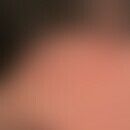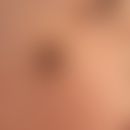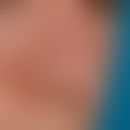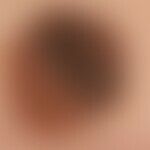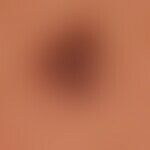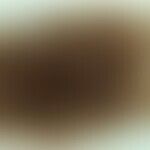Synonym(s)
DefinitionThis section has been translated automatically.
Benign, congenital or acquired, melanocyte-derived, brown to brown-black, rarely reddish or skin-colored, patchy, plaque- or tumor-like, soft pigment tumor, usually occurring in plural but also solitary forms. Melanocytic naevi may be located in the epidermis (junctional melanocytic naevus), in the epidermis and dermis (compound type of melanocytic naevus) or exclusively in the dermis (dermal melanocytic naevus).
Occurrence/EpidemiologyThis section has been translated automatically.
The prevalence of melanocytic nevi depends on age, ethnicity, genetic predisposition and environmental factors.
- Few (to no) melanocytic naevi are present at birth. There is an increase in occurrence during the first 3 decades of life and a regression with increasing age. Melanocytic nevi develop particularly rapidly up to puberty. The largest number of melanocytic naevi is observed between the ages of 20 and 30. They increasingly disappear later in life, whereby these regression phases are apparently dependent on further UV exposure.
- Fair-skinned people (Caucasian race) have a greater number of melanocytic nevi than members of darkly pigmented races, especially African-Americans and Asians. Melanocytic nevi on the palms and soles of the feet and in the nail bed are more common in dark-skinned people and Asians than in Caucasians.
- An increased number of melanocytic nevi has been shown in families with a family history of melanoma.
- Environmental factors such as sun exposure clearly influence the development of melanocytic nevi. Phenotypic risk factors for the development of nevi in children and adolescents include a tendency to sunburns, freckles, blue eyes and light-colored hair in addition to light skin type.
- There is clear evidence that fair-skinned individuals who grow up in sunny climates have a greater prevalence of melanocytic naevi than those who grow up in temperate temperature zones. Studies on small children have shown that the number of melanocytic naevi in fair-skinned children correlates with the frequency of vacations.
-
The influence of medication: An increased number of nevi has been described with the use of certain medications such as oral contraceptives and immunosuppressants (Kretschmer L et al. 2023).
You might also be interested in
ClinicThis section has been translated automatically.
"Ordinary" acquired melanocytic nevi are well defined, round or oval, solitary or multiple, mostly axisymmetric, well defined lesions with regular margins and a diameter of 0.2-0.6 cm.
The following basic types are distinguished:
I. Nevus melanocytic junctional type: spotty or plaque-like lesions, usually uniformly medium to dark brown in colour.
II. Nevus melanocytic compound type: lesions of varying height and generally lighter in colour than junctional melanocytic nevi. With constant growth activity of the nevus with the formation of further melanocytic nests in the junctional area, these nests increasingly "drip" into the dermis where they are found as "classical nevus cell accumulations" nestlike or diffuse. This penetration of melanocytes into the dermis has nothing to do with an "infiltrating growth" of a malignant tumour, but rather with an "outgrowth" of the cells into the dermis, in an environment untypical for a melanocyte. In this environment the melanocyte loses its dendritic form and usually also its ability to form pigment. It rounds itself off and takes on a lymphocyte-like shape.
III. Nevus melanocytic dermal type: This is a regressive melanocytic nevus which has lost its epidermal (growth) component after an active growth phase in the 2nd half of life. Clinical presentation: Mostly flat raised, also more papillomatous and clearly brighter than compound nevi. The colour ranges from light brown to reddish to skin-coloured.
Clinical overlaps between all 3 melanocytic nevus types are possible. Dermal nevi and also compound nevi may be hemispherical or papillomatous in shape or may resemble seborrheic keratoses in case of verrucous growth. Many older melanocytic nevi contain strong bristly, mostly dark pigmented hair.
Melanocytic nevi at special locations:
- Melanocytic nevi on palms and soles are usually patchy or only slightly raised. They have regular and sharply defined boundaries and show a uniform brown pigmentation.
- Melanocytic nevus of the nail bed: In this localization the new formation usually shows as uniformly pigmented, brown to dark brown, longitudinal, sharply defined stripes running through the entire nail plate.
For melanocytic nevi, the following clinical signs are considered to indicate a malignant degeneration(ABCD rule)
- A = Asymmetry (unequal halves on both sides of an imaginary midline)
- B = Border irregularity (irregular limitation)
- C = Colour variation, especially occurrence of black, grey, red tones, fading of individual components (most important criterion)
- D = Diameter (diameter): more than 5 mm or size growth
If all four criteria are met, a pigmented skin change is highly suspect of a malignant melanoma. Exophytic growth (E = elevation) can be included as the 5th parameter in the assessment of the tumour.
- E = Elevation
Remember! The ABCD rule is generally accepted as a guideline for dignity criteria of melanocytic nevi. However, it often fails in nodular malignant melanoma, but especially in amelanotic malignant melanoma (colour variation)
HistologyThis section has been translated automatically.
Histologically 3 forms can be distinguished:
- Junction type (initial epidermal stage)
- Compound type (epidermo-dermal)
- Dermal type: Dermal melanocytic nevus.
Melanocytic nevi show intraepidermal and/or dermal accumulations of melanocytes. The melanocytes within the junctional zone have a round, oval or spindly appearance and lie in contiguous nests. In the superficial dermis, the cells generally have an epithelioid cell character with medium-sized, usually centrally located nuclei and a distinct cytoplasmic border. The degree of pigmentation varies, either finely granular or cloggy distributed over the cytoplasm. The nuclei show a uniform chromatin distribution with a slightly clumped texture. Deeper in the dermis the melanocytes lie in strands. The cells often show a reduced cytoplasmic content. They resemble lymphocytes and are often arranged in linear strands but also diffusely. The skin appendages are covered by the dermal melanocytes, but always remain intact
Differential diagnosisThis section has been translated automatically.
Differential diagnosis melanocytic nevi
- Malignant melanoma
- Blue nevus
- Spitz ne vus
- Spilus nevus
- Halo nevus
- Lentigo simplex
- Nevus fuscocoeruleus
- Café-au-lait stain
- Ephelid
- Becker nevus
- pigmented basal cell carcinoma
- Dermatofibroma
- thrombosed hemangioma
- pigmented verruca seborrhoica
- Neurofibroma
Complication(s)(associated diseasesThis section has been translated automatically.
An important aspect of the melanocytic nevus is its relationship to malignant melanoma. Many melanoma patients report that the melanoma has developed on a previously long-existing nevus. Histological studies show that about one third of melanomas are combined with parts of a melanocytic nevus. An increased number of melanocytic nevi indicates an increased risk of melanoma.
TherapyThis section has been translated automatically.
- Inconspicuous melanocytic nevi do not require treatment. However, since the risk of developing malignant melanoma is increased in patients with many nevi, the risk status of the patient should always be documented by determining skin type, age, family history, UV exposure, and the number and degree of dysplasia of existing nevi.
- Regular, specialist skin check-ups, 1-2 times/year.
- Abnormal nevi should be excised or their size should be recorded by photo documentation and scale and checked regularly. Incident light microscopy is used as a diagnostic tool.
- Protect especially children from radiation exposure and sunburn.
- Patients with increased risk: Avoid the sun or textile and chemical/physical sun protection; avoid tanning salons.
- Instructions to the patient for self-control
Progression/forecastThis section has been translated automatically.
The total number of melanocytic nevi and the presence of dysplastic melanocytic nevi is a significant risk factor for the development of malignant melanomas. In large congenital pigmented hairy nevi, melanoma develops in 10-25% of patients, sometimes as early as childhood.
LiteratureThis section has been translated automatically.
- Garbe C (1992) Sun and malignant melanoma. Dermatologist 43: 251-257
- Hesse G et al. (1994) Microfilm documentation in the follow-up of melanocytic tumors. Dermatology 45: 532-535
Kretschmer L et al. (2023) Darker Fitzpatrick skin phototype and solarium visits associated with increased melanocytic nevus count in adults. J Dtsch Dermatol Ges 21:645-647.
- Maitra A et al. (2002) Loss of heterozygosity analysis of cutaneous melanoma and benign melanocytic nevi: laser capture microdissection demonstrates clonal genetic changes in acquired nevocellular nevi. Hum Pathol 33: 191-197
- Ruiter DJ et al. (2003) Current diagnostic problems in melanoma pathology. Semin Cutan Med Surg 22: 33-41
- Schulz H (1992) Incident light microscopic score for the differential diagnosis of dysplastic nevi. Dermatologist 43: 487-490
- Schulz H (1994) Reflected light microscopic criteria of benign melanocytic pigmented moles of the skin. Act Dermatol 20: 2-6
- Synnerstad I et al. (2004) Fewer melanocytic nevi found in children with active atopic dermatitis than in children without dermatitis. Arch Dermatol 140:1471-1475
- Tomita K et al. (1998) A nevocellular nevus consisting mostly of nevic corpuscles. J Dermatol 25: 134-135
Incoming links (1)
Ordinary melanocytic nevus;Outgoing links (19)
Abcd rule; Basal cell carcinoma (overview); Becker's nevus; Blue nevus; Café-au-lait stain; Deltoideoacromial nevus; Dermatofibroma; Ephelids; Keratosis seborrhoeic (overview); Lentigo simplex; ... Show allDisclaimer
Please ask your physician for a reliable diagnosis. This website is only meant as a reference.

